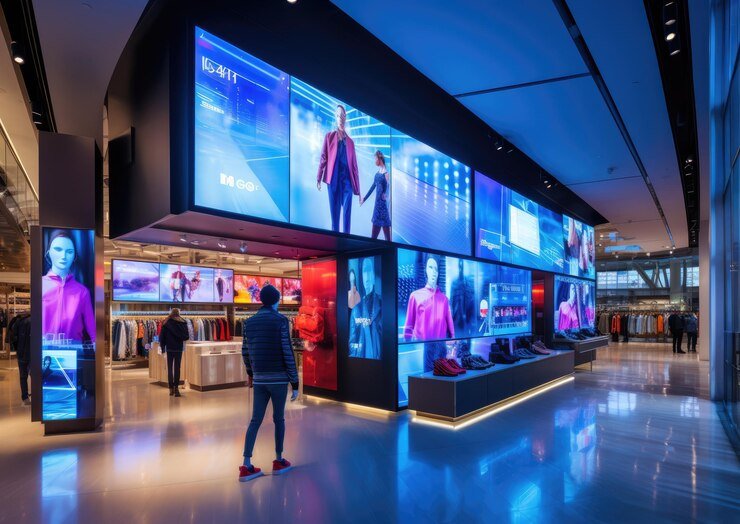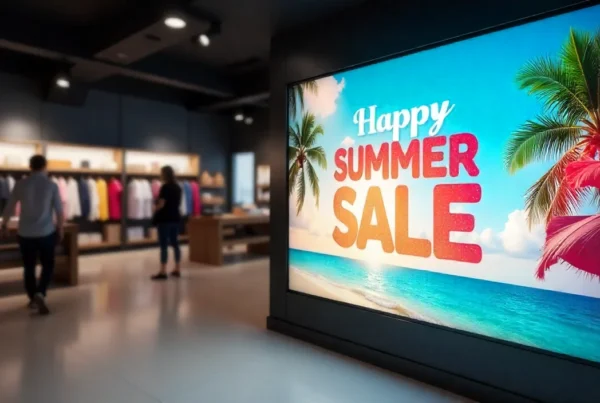In today’s fast-moving, visually-led world, a digital menu board is a powerful tool for businesses in pursuit of capturing attention and delivering messages, all aimed at enhancing the customer’s experience. No matter what your business is—retail, hospitality, education, healthcare, or any other—the digital signage solutions provider can change your entire communication strategy and bring massive results. This comprehensive guide explores the importance of digital menu board and the benefits that come with selecting the right provider, including future trends in this space.
The Rise of Digital Signage
What is digital menu board?
It is the use of digital displays in the form of LED screens, LCD monitors, or projection systems, which can deliver dynamic content in many formats: text, images, video, and interactive elements. In fact, these displays appear in public areas, retail stores, corporate environments, transportation hubs, and so on.
The Evolution of Digital Menu Board
It has evolved from its early systems, which consisted of simple, static displays that were updated manually in the course of a few decades. Today, with evolved technologies, it has come into place with sophisticated networked systems capable of deploying real-time, interactive, and targeted information in numerous places.
Why It Matters
In this world where the consumer is surrounded by information coming from every angle, digital menu board is one sure way to be conspicuous and put messages across. Digital content changes dynamically, being livelier than static tradition, thus attracting customers and increasing the power of business communication and marketing.
Benefits
Enhanced Customer Engagement
One of the main benefits a digital menu board offers is the ability to have higher customer engagement. In other words, digital signage and dynamic content provide a higher opportunity for customers to catch a person’s eye with the signs. At that rate, signs bring about more engagement, leading to higher brand recall, increased customer satisfaction, and, in turn, more sales.
Flexibility and Real-Time Updates
Updating, when necessary, at any given time, is easy on digital signs. This enhances flexibility in the changing of content. In case of a change of situation, offer, or information about the product, this will be of great importance.
Cost-Effective and Sustainable
Even though the initial investment might be quite high compared to traditional signage, digital signage is cost-effective and sustainable in the long run. There are no printing costs, and the content is digital, which makes updating it less wasteful and more sustainable.
Targeted Messaging
It enables businesses to deliver appropriate messages to targeted audiences at the point of purchase. For example, a retail store can display different promotions at different sections of the store, or an office can show one type of message for its employees and another one for its visitors.
Data and Analytics
Most of the modern digital signage solutions have built-in analytics capabilities, thus helping the business track metrics and measure the effectiveness of the content in deriving customer behavior insights. Such a data-driven approach is useful in optimizing content strategies and hence improving ROI.
Choosing the Right Digital Signage Solutions Provider
Assessing Your Needs
Before you choose a digital menu board solution provider, you have to know what you want to achieve and why. Here are some questions you ought to be asking yourself:
- What exactly do you want to achieve with your digital signage? Do you wish to enhance customer engagement, internal communication, or drive sales?
- What kind of content will you display? Will it be static images, videos, interactive content, or a mix?
- Where will the digital menu board be located? Indoor, outdoor, single location, or multiple locations?
- What is your budget? Consider both the initial investment and ongoing maintenance costs.
Key Features to Look For
When evaluating solution providers, look for the following key features:
- High-Quality Displays: Look for solution providers that feature high-quality, high-definition screens that are bright and viewable from wide angles.
- Content Management System (CMS): A robust CMS will allow for simple management of your content and ease of updating. This should be very user-friendly with capabilities of remote control.
- Customizable Solutions: The provider should be able to deliver custom solutions based on your most specific needs, including screen sizes, layouts, and interactive features.
- Integration Capabilities: Make sure the digital menu board can be integrated with the likes of your POS, CRM, or inventory management systems.
- Scalability: Get a provider that can scale with your business—one that can start you off with one screen or multiple locations.
- Support and Maintenance: Proper customer support and maintenance services go a long way to ensure uninterrupted services from your digital signage system.
Evaluating Providers
Having established your needs and the key features, it’s time to check the prospective providers. Some of the steps include:
- Research and Shortlist: Carry out intensive research to identify the shortlisted, reputed providers. Go through reviews, case studies, and testimonials to judge their track record.
- Request Demos: Request a demo from the shortlisted providers to see the product first-hand. Look at its user interface, how easy it is to use, and all its features.
- Ask Questions: Be prepared with your list of questions which could be asked of each vendor—this can include how long they’ve been in your industry, any ability to customize, support, and pricing.
- Compare Proposals: Evaluate proposals from multiple providers, comparing features, pricing, and support offerings. Consider long-term value, not just cost.
- Check References: Request references of clients they have worked with in the past and contact them to learn about their experience.
Making the Decision
Reviewing the providers is the easy part of selecting a provider. The more difficult task is making the decision. Selecting a provider should be determined by whether they meet the needs of your project, demonstrate the best value, and prove a commitment to customer satisfaction. Remember that the best provider should actually be your partner in the journey of digital signage, giving continued support and innovation to ensure your goals are achieved.
Implementation and Best Practices
Planning and Design
It is most effective when it is carefully planned and designed. Practice the following:
- Content Strategy: Develop a content strategy that supports your business objectives and audience. Plan a mix of content—promotion, information, and entertainment.
- Visual Design: Purchase or create high-quality visuals that follow your brand’s design. Use eye-popping images, transparent typography, and balanced layout for readability.
- Placement: Use strategic spots on your signage to have the maximum effect on vision. Factors such as foot traffic, viewing angles, and lighting conditions must be considered.
Content Creation and Management
Content needs to be created and managed for the digital menu board on a continuous basis. Use these best practices:
- Keep Content Fresh: You need to update content regularly to keep it relevant and engaging. Static content can create viewer fatigue and ultimately reduce its effectiveness.
- Use Data-Driven Insights: Utilize your analytics to learn what sort of content resonates with your viewers. Use those insights to redefine a content strategy and work on engagement metrics.
- Balance Promotion and Information: It’s one thing to have promotional material, but balance it out with something informational or something that adds value for the viewers.
Technical Considerations
Digital menu board implementations present a few technical considerations:
- Network and Connectivity: Both the wired and wireless options may be adopted by considering physical site considerations. The network must be reliable and support real-time updates; it should provide remote management.
- Hardware Maintenance: Periodic inspection and maintenance of all the hardware help in ensuring zero downtime. This includes screen cleaning, connection checks, and firmware updates.
- Security: Deploy the right kind of security for your signage system to protect it against unauthorized access and cyber threats. Secure passwords, data encryption, and consistent software updates are some of the ways in which you can maintain security.
Measuring Success
To measure the success of your digital signage campaigns, keep a keen eye on the following key performance indicators:
- Engagement Metrics: How users engage with your content; these metrics include the number of views, interactions, dwell time, etc.
- Sales and Revenue Impact: Analyzing sales data will provide measures for an increase in revenue and customer response due to digital signage.
- Customer Feedback: Gather customer feedback to understand their perceptions about your digital menu board and areas of improvement.
Future Trends
Artificial Intelligence and Machine Learning
AI and machine learning are all set to give a new life to digital signage, one that is more personalized and intelligent in the delivery of content. AI-based algorithms can be devised to analyze customer data and behavior to bring in targeted messages, optimize content scheduling, and help enhance the overall efficacy.
Interactive and Touchless Technology
Making them rise in the scene of its interactivity level. The usage of touchscreen displays, gesture-based controls, and speech recognition technologies helps make the experience more engaging and immersive, thus making environment bythe digital menu board an interactive and user-friendly experience.
Augmented Reality (AR) and Virtual Reality (VR)
Augmented and virtual reality are emerging as new opportunities for unique, memorable digital signage experiences. This is where AR comes in, where it overlays digital content in the real world, making product demonstrations or brand experiences more interactive. VR can transport the user to an immersive environment using creative ways to showcase a product or service.
Sustainability and Eco-Friendly Solutions
Since sustainability is becoming more of an issue, providers will aim to target green products, green materials, and efforts towards e-waste mitigation. Businesses can align their digital menu board efforts with their sustainability goals.
Integration with IoT and Smart Devices
The Internet of Things makes connections with smart devices, allowing it to act in real-time through the installation of digital signage. This will lead to a more responsive and adaptive way of presenting content. For example, in real-time, based on weather conditions, foot traffic, or even inventory levels, the digital menu board can adjust its content presentation.
Advanced Analytics and Insights
The future of digital menu boards, big data, and AI lies in advanced analytics and insights from sources yet unknown. Such analytics will provide businesses with deeper insights into audience behavior, content performance, and return on investment. Continuous improvement and optimization of strategies are expected to follow from these insights.
Conclusion
There are several benefits that the powerful tool of digital menu board offers to different businesses across various industries. Choosing the right digital signage solution provider can make all the difference in realizing the full value that technology has to offer. Make an engaging and effective strategy by accessing needs, evaluating providers, and best practices for implementation, which can bring results. The future of digital menu board is really promising as technology continues to grow. The best part is that, with AI-driven personalization and interaction, up to immersive engagements, businesses can leverage these leading innovations to elevate their communication and marketing efforts. Stay ahead of the curve by continuously learning what’s new, and in the future, optimize your signage strategy for delivering outstanding experiences to your audience.





